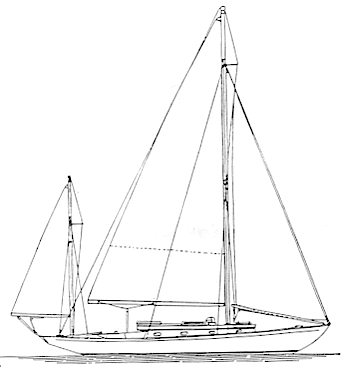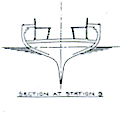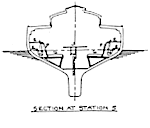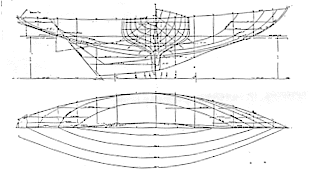 |
 |
 |
 |
 |
 |
Concordia Yawl
| Particulars | |
| Length on Deck | 39'10" |
| Length on Waterline | 28'6" |
| Beam | 10'3" |
| Draft | 5'8" |
| Displacement | 18000 lbs. |
| Ballast (Iron Keel) | 7700 lbs. |
| Sail Area | 650 sq.ft. |
 |
 |
 |
 |
 |
 |
Construction - The Concordias were built with an oak keel, steam bent oak frames, African mahogany planking, varnished mahogany deck trim, a canvas covered main deck and house top, bronze plank fastenings, and galvanized keel bolts through a iron keel. There were a few variations from this including the occasional lead keel. Naturally some have had repairs that may have altered these specifications somewhat. It is common to find that the canvas deck covering has been replaced with fiberglass. See the general material below for information on one particular type of repair.
Rig - The spars are hollow wood including the spinnaker pole. The standing rigging is stainless steel. Galvanized tangs were originally used. most other fittings and the winches were bronze. Concordias were normally supplied with mainsail, jib and mizzen and were felt to be sufficiently rigged to not require additional sails. Particular owners may have increased the inventory. The running rigging was intended to be Dacron and this is of course essentially universal today.
Engine - The original engines were generally Gray 4 cylinder 30 horsepower gasoline engines. The controls are led to the cockpit and the propeller is a two blade prop in an aperture on the centerline. Many of these engines have been replaced by diesels but some of the original engines are still in service.
Plumbing & Tanks - The head originally had a conventional pump head and a sink. There is also a sink in the galley. There is a built in bilge pump. There are three tin lined copper water tanks totally about 60 gallons. There is also a tin lined copper gasoline tank.
Cabin Furnishings - There are two folding berths forward and two of the famous Concordia berths in the main cabin. These berths all fold out of the way in the day time to leave nice comfortable transom seats with cushions. All the cushions were originally kapok filled. Presumably most people have now replaced much of this with foam. There is a cabin table, an icebox that holds 50 lbs. of ice, and originally an alcohol stove. Many stoves have, naturally, been replaced by newer units. There are seven electric lights and one kerosene lamp. Cockpit cushions are standard.
Other Equipment - The running lights and anchor light are electric. The Concordias came supplied with anchor and rode, boat hook, flag staff, canvas bucket, mop, a few tools, fenders, life ring, docking lines, compass and binnacle, life lines, pulpit, dinghy chocks.
Finish - Spars are varnished. On deck trim and house sides are varnished. Decks are buff, bottom paint originally green, cockpit sole teak. The interior was of varnished pine with hardwood trim. The cabin overhead is white. The cabin sole is teak. The head is all white except for the floor.
Much of the above is taken directly from Concordia company literature as are the illustrations above. When I was a boy these were among the premier sailing yachts around in the view of my parents and their friends. Interestingly enough 40 years later they are still among the most sought after cruising sailboats. The owner of a Concordia feels themselves a very lucky person and rightly so. Why is this?
First and foremost the Concordias were developed by Waldo Howland. Make no mistake, Mr. Howland had the boats drawn up by C. Raymond Hunt, but I firmly believe that without Mr. Howland's extensive devotion to proper cruising sailboats and his keen perception of how boats are best used for greatest happiness these boats would not be the well loved vessels they are today. Every detail of these vessels was painstakingly compared not to fashions, not to marketing trends, but to the actual needs of real cruising sailors. As you might expect not only did this produce a remarkable cruising boat but a fast one.
Because this boat was turned out by someone with a real long time sailing background the boats are simple, inexpensive to operate, fast, and very easy to handle. You will look in vain for clusters of winches or enormous genoas. They are simply not necessary. Though running backstays must be tended at times tacking is largely a matter of simply putting the helm down. With the self-tending jib there is not dodging about pulling and cranking. I have seen a Concordia sailed easily by a woman in her 80s with the help of a boy. It is my understanding that this particular woman was still sailing in her mid-90s.
Nothing in this boat was done to show off or impress. Everything was done just to be "right". The result? It is one of the most impressive boats you are likely to see. It's understated rightness remains impressive decade after decade. The amount of human happiness these boats have helped provide over the decades should qualify Mr. Howland for sainthood. There is no reason why they should not go on providing happiness for decades more to come.
Is there a flaw in these boats? After 40 years or so on average I think we have found only one. At the time they were built I don't think it was sufficiently understood that steambending a frame to a very tight curve inherently weakens it. As one can see from the sections in the lines drawing there are some pretty tight bends. As a result there have been a number of frames that have cracked over the years. To properly repair these is not all that expensive and not very difficult. However your surveyor should check very carefully for cracked frames in these areas and for poor repairs. Even today not everyone understands that the practice of sister framing is improper and results in a weaker boat than original. Those wishing to repair frames that have had problems should obtain a copy of our article "Healing the Break". This is available in back issues of WoodenBoat (see their on line index) and is available reprinted under another title in the WoodenBoat Series book "Frame, Stem & Keel Repair" which is available through our web site, your library, or through WoodenBoat. We also sell reprints in the publishing section of the website.
 |
| Lines of the Concordia Yawl |
We will be happy to help you find a Concordia. We can highly recommend the design. Usually we know of several for sale. These boats are rapidly achieving the status of collector's items and it would enhance many people's lives to own one. As always we recommend an independent survey by a person familiar with traditional and modern wooden boat repair and construction.